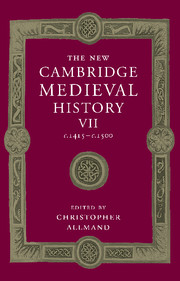Book contents
- Frontmatter
- PART I GOVERNMENT
- PART II ECONOMIC AND SOCIAL DEVELOPMENTS
- PART III SPIRITUAL, CULTURAL AND ARTISTIC LIFE
- 10 Religious Belief and Practice
- 11 Schools and Universities
- 12 Humanism
- 13 Manuscripts and Books
- 14 The Beginning of Printing
- 15 Architecture and Painting
- 16 Music
- PART IV THE DEVELOPMENT OF EUROPEAN STATES
- Appendix Genealogical Tables
- Primary Sources and Secondary Works Arranged by Chapter
- Index
- Frontispiece
- Plate section
- Map 1 European towns in the late Middle Ages
- Map 2 European commerce and trade
- Map 4 Winds and currents facilitating the discoveries
- Map 5 The universities o f Europe in 1400 and 1500
- Map 6 Germany and the Empire
- Map 20 The Roman Orthodox and Ottoman worlds in the fifteenth century
- References
16 - Music
from PART III - SPIRITUAL, CULTURAL AND ARTISTIC LIFE
Published online by Cambridge University Press: 28 March 2008
- Frontmatter
- PART I GOVERNMENT
- PART II ECONOMIC AND SOCIAL DEVELOPMENTS
- PART III SPIRITUAL, CULTURAL AND ARTISTIC LIFE
- 10 Religious Belief and Practice
- 11 Schools and Universities
- 12 Humanism
- 13 Manuscripts and Books
- 14 The Beginning of Printing
- 15 Architecture and Painting
- 16 Music
- PART IV THE DEVELOPMENT OF EUROPEAN STATES
- Appendix Genealogical Tables
- Primary Sources and Secondary Works Arranged by Chapter
- Index
- Frontispiece
- Plate section
- Map 1 European towns in the late Middle Ages
- Map 2 European commerce and trade
- Map 4 Winds and currents facilitating the discoveries
- Map 5 The universities o f Europe in 1400 and 1500
- Map 6 Germany and the Empire
- Map 20 The Roman Orthodox and Ottoman worlds in the fifteenth century
- References
Summary
all the evidence we have decrees that music permeated every walk of fifteenth-century life, from popular and aristocratic entertainment to religious and civic ritual. The range of types involved must have been formidable – vernacular music reflecting the activities and preoccupations of the common people, including also music for popular religious worship and popular drama; the ‘official’ music of the Church, especially the unaccompanied plainchant melodies supposedly hallowed by the pen of Pope Gregory the Great, and passed down through subsequent generations; music for all manner of festive occasions, ranging from the most functional of fanfares to the specially commissioned major work; music for the fifteenth-century nobleman, often designed less to help him while away the hours than to demonstrate the splendour of his establishment, the refinement of his taste and the personal piety with which he lavished resources on his chapel. Music was sung or performed on instruments, executed by individuals or groups, played by ear, improvised or read from notation; as a branch of the quadrivium, it even became a cerebral pursuit, in which sound might give way entirely to philosophical and mathematical speculation.
Keywords
- Type
- Chapter
- Information
- The New Cambridge Medieval History , pp. 319 - 334Publisher: Cambridge University PressPrint publication year: 1998

